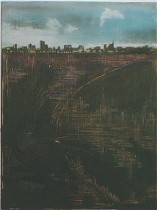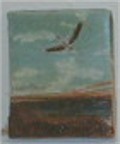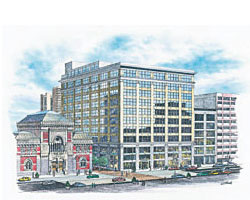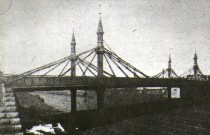Ed. note: In celebration of Artblog’s 10-year anniversary, we are bringing you content from our inaugural year, 2003. In October, 2003, Philly was shaking off its “kid brother” reputation to remind the world that there is more to the East Coast art world than NYC. Philadelphia and Artblog have since shoved our way out of the Big Apple’s shadow- bye bye “inpheriority” complex!
——————————-
Report from the fringe
By libby
There’s more than one way for an artist to show work, and it doesn’t have to be on a clothesline–but the tiny little cubby of a gallery, Well Fed Artists, on 3rd Street between Market and Arch, is pretty close to a clothesline.
The art there is hung “salon style,” or not only next to but above and below. The place has pictures that you need to crane your neck to see.
And kind of like City Hall, it’s a pay-to-play kind of place (oh, so are all galleries, but this one does it in a low-rent, honest kind of way). You pays your money and you gets a piece of wall three times a year.
I stopped by one chilly afternoon and found co-owner Jim O’Kane (the other owner is Maggie Hobson) sitting at the desk, surrounded by lots and lots of work, some of it his own.
O’Kane, like most artists, isn’t quite comfortable describing himself as an artist because he does so many things–whatever crosses his mind, he said. For example, he’s got a a claymation project for which he wrote the script. It’s out there looking for a producer. What he doesn’t do is repairs, he joked, when a doorknob came off in my hands.
Last First Friday, I mentioned some artwork I had seen in this gallery, but I didn’t know who painted it. So here’s the info: The pieces were by Faye Koplovitz, a 2002 graduate form Philadelphia University, who’s painting while she wrestles with the job market.

The oily little paintings are really painting/collages. They’ve got pieces of screen embedded and embellished with paint; they’ve got bitty images cut from old magazines and decoupaged on; they’ve got thread embedded.
Over the phone, Koplovitz said she was interested in issues like ecology and and earth, but also in isolation. Her statement on the wall at the gallery also mentioned “poverty and the effects of technological advancements on Western Culture.”
So even if this is an interim endeavor for her, Koplovitz is not to be taken lightly, and these paintings are juicy, textured and a bargain. If I hadn’t spent my last penny (literally) on some batteries for my camera, I would have put my money down. “City at Dawn” (shown at top, about 16 inches) is $55. The smallest pieces, about 4 inches wide, like “One Bird” (shown left), are $9.

Just to give a sense of the range of stuff in this gallery, I also put up an image of some of Todd Marrone’s cartoon figures, that go for $25.
In between, there’s all sorts of stuff, some not very good, some of interest. The artists have to pass a minimal jurying.
As a shopper, you take your taste in your hands when you go in there, but how much do you have to lose with prices like these?
And how much does an artist with no track record have to lose? Well, if you look at the gallery’s website, you can see what the deal is. Then you do the math.
——————————-
Building in a weak economy
By roberta
I read at artnet that the Bellevue Museum of Art in Washington state has closed, a victim of financial woes at a time of economic recession. Bellevue may have shot itself in the foot when it ponied up big bucks for a new building which opened in 2001 just about the time the economy started to sour. (The Milwaukee Art Museum, which went into deficit spending on its new Calatrava addition at about the same time is also in a pickle.) And let’s not even talk about the Guggenheim’s building expansion and how that’s busted the bank.
 Locally, the Philadelphia Museum of Art is running a big capital campaign to rennovate its new Perelman Building across the Parkway (Perelman, an ornate, 1920’s-era art-deco building that used to house Fidelity Mutual Life Insurance Company will house administrative offices and part of the collection — costumes and textiles and prints, photographs and works on paper.) Rennovation of the existing structure is estimated at $25 million. A three-story expansion to the building’s rear will cost more. (black and white drawing, above, of Perelman when it was FMLIC home)
Locally, the Philadelphia Museum of Art is running a big capital campaign to rennovate its new Perelman Building across the Parkway (Perelman, an ornate, 1920’s-era art-deco building that used to house Fidelity Mutual Life Insurance Company will house administrative offices and part of the collection — costumes and textiles and prints, photographs and works on paper.) Rennovation of the existing structure is estimated at $25 million. A three-story expansion to the building’s rear will cost more. (black and white drawing, above, of Perelman when it was FMLIC home)
 Pennsylvania Academy of the Fine Arts likewise is fundraising for its new Hamilton Building, a 1915 building that used to house federal offices, next to the PAFA Furness Building. Hamilton will house offices, classroom space and a first-floor gallery. PAFA’s website lists Hamilton as a$50 million project. (architect’s rendering, above, of big Hamilton next to little Furness)
Pennsylvania Academy of the Fine Arts likewise is fundraising for its new Hamilton Building, a 1915 building that used to house federal offices, next to the PAFA Furness Building. Hamilton will house offices, classroom space and a first-floor gallery. PAFA’s website lists Hamilton as a$50 million project. (architect’s rendering, above, of big Hamilton next to little Furness)
And of course there’s the Barnes Foundation, teetering on bankruptcy and hoping, Orphans Court permitting, to raise money and move to a building on the Parkway. How many funders are out there for all these projects and how deep are the pockets? It probably helps that PAFA and PMA are retrofitting old buildings and not starting from scratch. But as an art consumer I want to know if i should expect to see the cost of museum entry go up again any time soon.
——————————-
The more things change…
By libby

Here’s a quote from Joseph Sill, a Philadelphia art patron:
“Philadelphia is not the place for an artist’s success. Indeed, the taste for the arts seems to be waning away in this city; and with our commerce we shall lose our refinement also.”
He observed that he couldn’t get people to buy local art, but the good citizens of Philadelphia laid down their dollars for art from Europe. He concluded that Philadelphia was “a sad place for artists.”
The quote from Sill, a merchant, is from 1844, and it came from “Philadelphia: A 300-Year History,” ed. Russell Weigley.
Sill was chairman of the Board of Managers of the Artists and Managers Association in 1841 and started the Art Union of Philadelphia several years later, only to see it dissolve in 1855 (image shown is the old 40th Street Bridge).
Certainly, what he said could have applied to Philadelphia until fairly recently; just substitute “New York” for “Europe” and you’ve got modern history. Have things changed much? Anyone dealers out there have an opinion?









